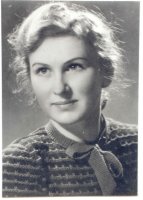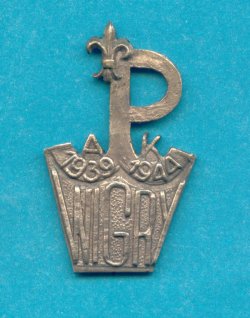
Barbara Gancarczyk-Piotrowska,
born on the 18th of October 1923 in Warsaw
the nurse of the Home Army
pseud. "Pajak" (=spider)
the 2nd platoon of the assault company
Scouts' battalion of the Home Army "Wigry"
Insurgent accounts of the witnesses
War Reminiscences of the nurse of the Scouts' battalion of the Home Army "Wigry" Barbara Gancarczyk-Piotrowska pseud. "Pajak" (=Spider)
The underground movement
I first came in touch with the underground movement at the end of 1941. I know that my father and my younger sister were also involved in the conspiracy. My sister had been involved in the underground organisation by a doctor who lived in our house. She had undergone the sanitary training. For the security reasons this subject was not discussed at home. We did not know who is involved and where.
As I have mentioned earlier, in 1941 I began the studies at the secret Architecture Department. Professor Stefan Bryla worked as a lecturer there. He was the co-organiser of the secret University of Technology, but most of all he was the head of the Public Works and Reconstruction Department in the Government Delegation for Poland. It was the ministerial level.
The professor needed women liaison officers. We had a friend in the Architecture Department, Zbyszek Smidowicz, whose father was friends with the professor. Professor Bryla knew Zbyszek, who had already worked for the underground movement, perfectly well. Zbyszek recommended me and my two friends: Wanda Manczarska and Stasia Witkowska to the professor. We were accepted. We took the oath and at the turn of 1941 and 1942 we began our service as women liaison officers.
In the city there were meeting places when one received the correspondence. It was usually information or notice about meetings. I do not know what it was, because I never looked into the tiny pieces of paper written on tissue paper. These were small pieces of paper, which could easily be hidden. I suppose that these were the news which reached through the Delegation even from London; it is hard to tell.
The contact points were in different places and changed quite often. These were private lodgings as well as shops. I received correspondence from the professor and I also brought correspondence for him. Professor Bryla forbade us to carry any newspapers. He told us that we absolutely could not put ourselves at risk by carrying packages.
The professor lived on 10 Noakowskiego Street. It was a large flat with several rooms. From the corridor one went to the professor's study on the right. The study was full of bookshelves reaching to the ceiling. It was a high-vaulted flat. In the bookshelves there were paper files, a lot of various old documents. I saw how the professor hid the correspondence which he got from me among the old papers. I was always wondering how he was going to find it, just in case. It turned out that when the professor was arrested in 1943, they found nothing in his flat.
We were the professor's women liaison officers to the very end. Two weeks before he was arrested, the professor had forbidden us to visit him. It was not the first time he was arrested. Before that, he had been arrested in 1941 or 1942. Then he was released for a lot of money and continued to work at the university.
During my service as a woman liaison officer I often met other professors of the University of Technology. I visited Professor Zachwatowicz, Hempel, went to Saska Kepa to Professor Poniz.
Professor Stefan Bryla was executed on 3 December 1943 on the Pulawska Street in the depot. There is a plaque there. A day of two before the professor's death I met another professor in the tram. When we got out, he told me:
"You know, the professor will be released, a huge ransom has been paid for him."
In spite of this his name was put on the execution list.
After the professor's death we did our service as women liaison officers for his assistant whose name I do not remember. The Department continued to work. I remember that I went to someone else then, to someone who had his point on the Koszykowa Street, near the Architecture Department. In general, we tried not to remember the names and the meeting places.
Against all the rules of conspiracy, because we were not allowed to belong to two organisations for security reasons, I absolutely wanted to get to the military organisation, to the Scouts' organisation. I managed to do it. At the beginning of 1942 I was admitted to the Scouts' battalion "Wigry" which had been already organised.

The badge of the Scouts' battalion "Wigry"
I did not have any particular tasks to do there. I mainly underwent the sanitary training, communication training, military training. Some of my friends managed to get practice in hospital, but I was trained in first aid, to be a nurse. They practised as nurses and were better qualified. Later, during the Uprising, they were assigned rather to hospitals, to the first aid stations, while we, the nurses, to the combat units.
We created five-person groups. The lectures took place in private lodgings, the addresses kept changing. We had rather a poor grasp of medicine, however, the lectures were conducted by a doctor or some of our friends who had graduated from medicine or were medicine grads. I remember Zosia Nowak-Loszczynska, Lidka Buczek. There were theoretical lectures and later practical classes. We learnt how to bandage, how to make injections.
First we made the injections on a sandwich. One of the friends had a dog on which we practised, but it ran away soon. Later, we made injections to one another. There was also the communication training. We went somewhere near Warsaw, somewhere to Kampinos Forest, Izabelin.
I do not remember my first pseudonym, I guess it was "Konarzewska." When I was admitted to "Wigry," the surnames were our pseudonyms.
The pseudonym "Pajak" (=spider) was not, in fact, chosen by me. It was how I was called. "Wigry" organised physical exercises in the Szelestowskiego gym. It was a well-known point on Hoza or Wspolna Street. Between Marszalkowska and Poznanska Street there was a large gym. Boys and girls went there for physical exercises. Also the SS-men went there for physical training. In the gym there were wall bars on which we practised.
I had always been terribly thin, I had long arms and legs. As I was hanging on these wall bars, my friends must have associated me with a little spider and this is how they called me. There are spiders with long, thin limbs. This nickname stuck to me and became my pseudonym.
Barbara Gancarczyk-Piotrowska
prepared by Maciej Janaszek-Seydlitz
translated by Katarzyna Wiktoria Klag
Copyright © 2012 Maciej Janaszek-Seydlitz. All rights reserved.